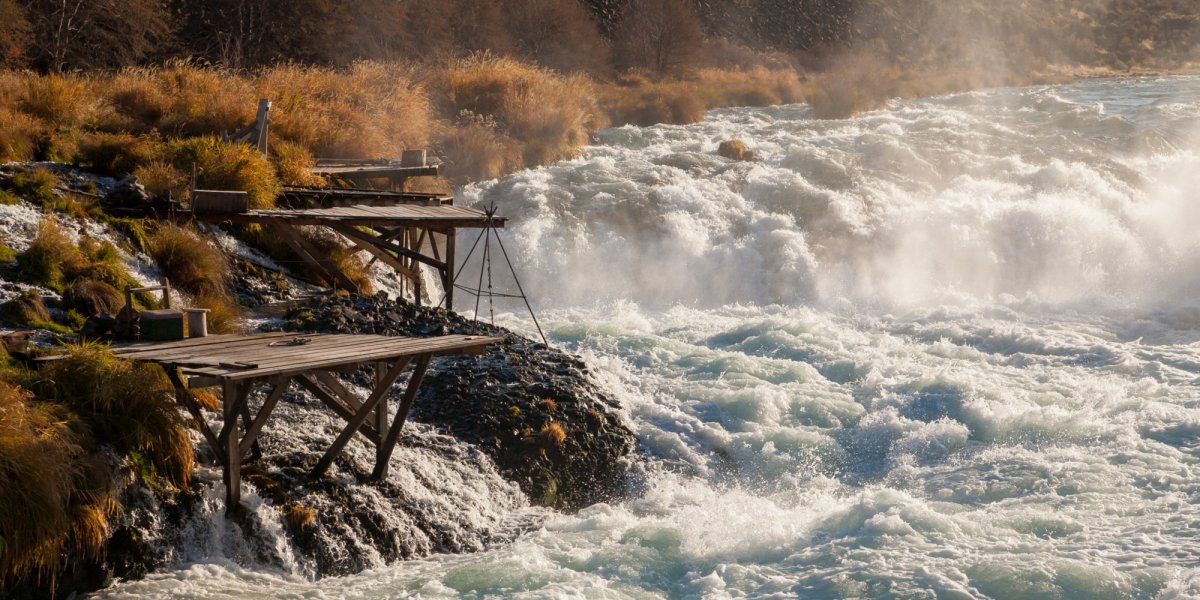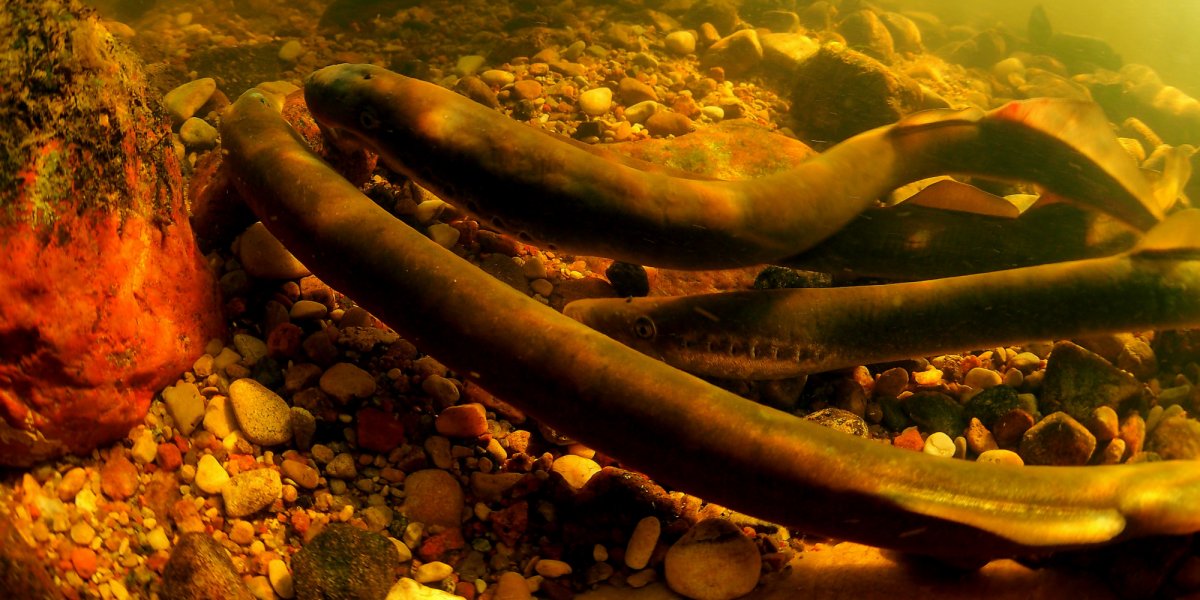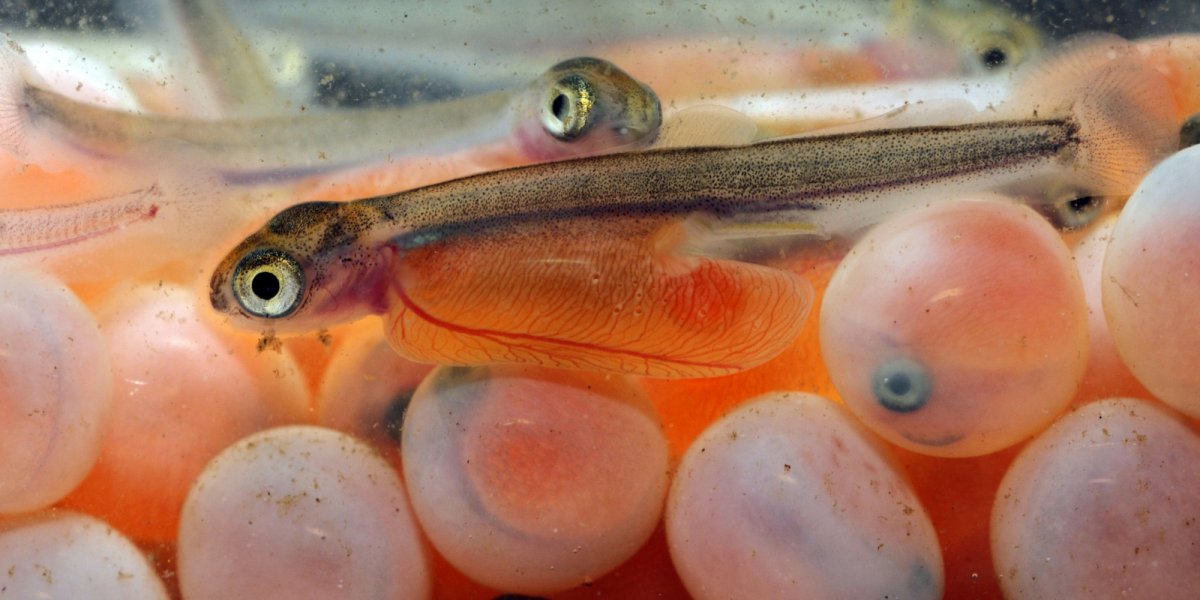The Lower Deschutes Wild and Scenic River is a legendary river for those who love fishing and is famous for both native rainbow trout and summer-run steelhead. It is also a river rich in lessons about fish biology and diversity. Floating the Deschutes is like being in a living classroom, where one can observe the natural history of fish in a very real way.
In addition to the native rainbow trout and steelhead, other native species include the mountain whitefish and the bull trout. Bull trout are a char, similar to brook trout and lake trout, that grow to become quite sizeable. They are protected as a sensitive species in Oregon as well as throughout most of their range in the West. Any that are caught must be released.

Historic dip net fishing platforms near Shearer's bridge falls on the Deschutes River near Maupin, Oregon.
For the Indigenous people of the area, the river’s fish were an important food supply. Every spring and fall, chinook and coho salmon would run up the Columbia from the Pacific, and those born in the Deschutes and its tributaries, would south into the Deschutes, returning to their spawning grounds to lay their eggs and die. These ocean-going fish are called anadromous, from the Greek for “running up.”
Another amazing anadromous fish that lives in the lower reaches of the Deschutes River are lampreys. They look like an eel but, are not eels at all, being more closely related to hagfish and sharks. They belong to an ancient extant lineage of jawless fish that is older than dinosaurs and salmon. Like salmon, they were also an important food source for native people and the land. Just as the dams on the Columbia have been a disaster for salmon, so it goes for the lamprey. Learn more about the lamprey in this article by the Columbian.

Example of Lampreys, an important species in the history of the Deschutes River
Salmon, steelhead, and lamprey numbered in the tens of millions in the Columbia watershed prior to 1800. Lewis and Clark canoed downstream on the Columbia river in 1805 and passed by the Deschutes River. After their winter on the Pacific Coast, they returned upstream, like the salmon, passing by the Deschutes once again in 1806. Their first mention of salmon on the Columbia was on October 18, 1805, when Sergeant John Ordway wrote in his journal “We Saw a great many dead Sammon floating in the river…” and “Saw the living jumping very thick.” Clark made a note in his journal that “the number of dead Salmon on the Shores & floating in the river is incredible to say.” Lewis and Clark knew little to nothing about the life-cycle biology of salmon and made no mention of possible reasons for seeing so many dead fish.
Of course, we know that salmon and steelhead migrate from the sea to the inland rivers where they spawn. Their return journey, to the place where they were born, takes them through powerful rapids and if necessary, up falls that are 10-15’ in height. Once they arrive at their natal nesting place, the female digs her nest, called a redd, in the gravel of the riverbed. She lays her eggs here as the male fertilizes them with his milt. The female then covers the eggs with gravel and, lifecycle complete, the adult fish die.
The baby salmon, hatch some 60 to 200 days later. At this stage, they are called alevins, live in the gravel to avoid predators and are nourished by the yolk of the egg sac. After 4 - 6 weeks, alevins finish their yolk sac and begin the next phase of life as fry. They are still very tiny and vulnerable, but they venture from underneath the gravel to eat microscopic creatures. After a year or so, salmon start the parr stage that will last from 1 to 5 years. At this point, they remain in the river, not far from the redd where they were born, and grow to a few inches in length.

Salmon Fry
Now 4 to 9 inches long, the salmon smolt is ready for its journey to the sea. When spring flows come, the small fish are carried downstream by the current, always looking upstream, all the way to the sea. During this time, the smolt’s internal organs transform so they can osmoregulate. This allows them to control the amount of salt and water in their body, a requirement for survival as they enter the ocean. Once in the ocean they swim and eat for 3-4 years before returning up the rivers to the place of their birth.
When there were millions of fish migrating up the Columbia River and all its tributaries, each fish weighing from 30 to 120 pounds, there was a virtual conveyor belt with thousands of tons of nutrients carried upstream in their bodies. As they reached their destination, spawned and died, their bodies became a rich fertilizer that was deposited and fed the land and animals around the rivers. Even today, when you take a core sample of a tree within 200’ of a salmon river, you will find the DNA of salmon! Over a hundred species depended on salmon as a food source including bear, mink, otter, raccoon, fox, scavenger birds like the bald eagle and vulture, and many others.
Numbers of salmon have plummeted in the last 200 years, primarily because of dams, but also due to overharvesting by commercial fishing operations that started as early as the mid-1800s. Better management, new fisher ladders, and hatcheries are helping to improve the numbers today, but it’s really a huge fish welfare system made necessary by the dams that have been built in the Columbia Basin. For a superb lesson on the natural history of salmon and their importance to native peoples as well as the environment, read this compelling short story by David James Duncan.

Example of a fish ladder along the Deschutes River in Oregon
The story of salmon is linked to every river in the Columbia and Snake river basin. The longest anadromous fish migration in the world belongs to the sockeye that travel from the Pacific, up the Columbia to the Snake, on to the Salmon, then to the Middle Fork of the Salmon and finally, some 900 miles later, arrive at Redfish Lake in the Sawtooth Mountains near Stanley, Idaho. It’s called Redfish Lake because it would literally turn red in the early fall when the salmon returned by the thousands. The Deschutes River salmon don’t have such an impressive journey, but it is nevertheless miraculous. The anadromous fish of the Deschutes turn south when they reach the mouth, and head upstream to tributary creeks surrounded by the vast Oregon desert. Here they create new life in the river’s gravel and die. We encourage you to learn more about the current peril that salmon face by reading this article.
The history of people is one filled with ignorance when it has come to understanding the environmental impact of our actions. In the 1800s chukar and ringneck pheasants were introduced from China to the American West because people wanted to hunt them as a game bird. In a similar fashion, almost every stream, river and lake in the United States has had non-native fish planted for sport fishing. The Deschutes is no exception and in certain sections, we find German brown trout and the eastern brook trout. On the lower river, closer to the Columbia, there is also non-native small-mouth bass.
Many people, including the tribes of the Deschutes area, are working hard to improve the health of the Deschutes River so that its fishery can better sustain native fish. A rafting trip on the Deschutes River is the perfect place to learn more about all these fish. Come join us to discover our natural world.
“The fish in the creek said nothing. Fish never do. Few people know what fish think about injustice, or anything else.” ― Ursula K. Le Guin, Catwings



